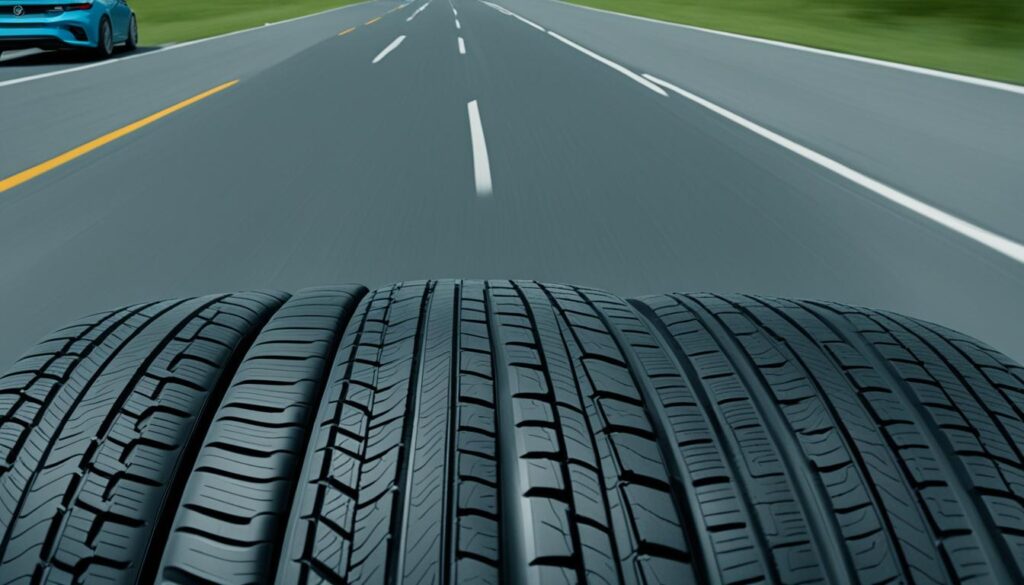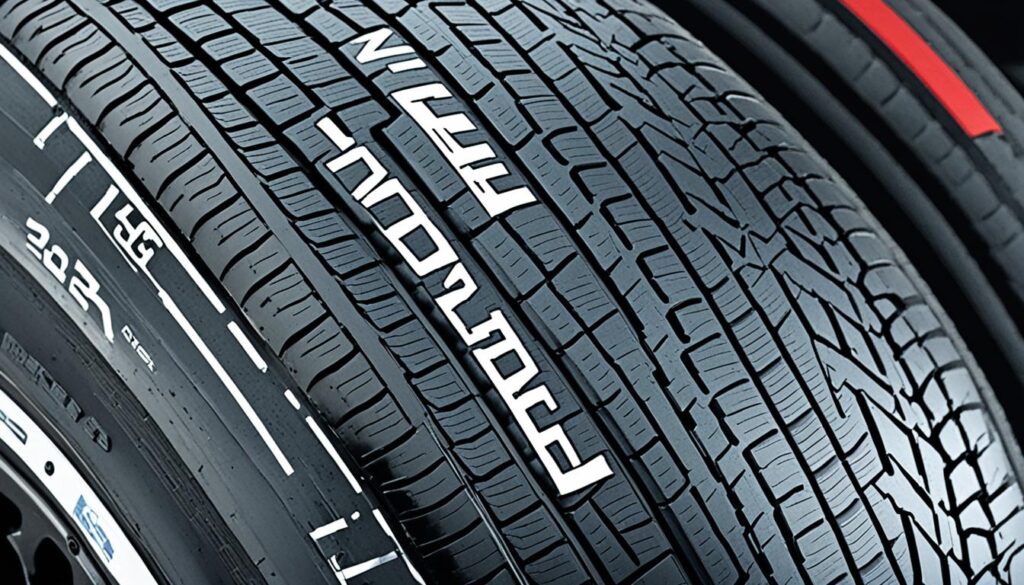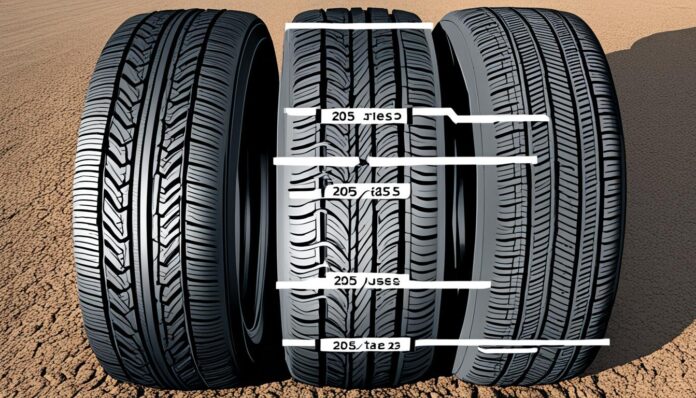As an Amazon Associate, I earn from qualifying purchases
Are you confused about the difference between 205 and 225 tires? You’re not alone. Many drivers wonder how these two tire sizes compare and what impact they have on their driving experience. In this article, we will break down the differences between 205 and 225 tires and help you understand their size impact on your drive.
Key Takeaways:
- 205 and 225 tires refer to the width of the tire in millimeters. A 205 tire is narrower than a 225 tire.
- The wider tire provides a larger contact patch with the road, which can offer more grip and stability.
- However, simply switching from a 205mm to a 225mm tire on the same-width wheels does not necessarily result in better performance.
- Mounting a 225mm tire on a wider wheel can significantly improve grip and overall tire performance.
- When choosing between 205 and 225 tires, consider factors such as your vehicle’s limitations, driving preferences, and specific needs.
The Importance of Properly Matched Wheels
When it comes to optimizing tire performance, having properly matched wheels is crucial. Various tests and studies have consistently shown that the width of the wheel can significantly impact tire performance, ultimately enhancing the overall driving experience. Mounting the right tire size on the optimal wheel width can unlock numerous benefits, resulting in improved acceleration, cornering ability, and overall handling.
One of the most notable benefits of wider wheels is the increased grip they provide. A wider wheel allows for a larger contact patch between the tire and the road surface, maximizing traction and minimizing slippage. This improved grip translates into better acceleration, as the tire can transfer power more effectively to the ground. Additionally, wider wheels enhance cornering, allowing the tire to maintain contact with the road during aggressive turns and providing greater stability.
“Properly matched wheels can greatly enhance tire performance, resulting in improved acceleration, cornering ability, and overall handling.”
To illustrate the impact of properly matched wheels, consider a test conducted using the renowned BFGoodrich g-Force Rival tires. In this test, it was found that mounting a 225mm tire on a wider wheel led to better lap times compared to the same tire on a narrower wheel. Specifically, lap times improved by half a second with the wider wheel setup, showcasing the performance advantages of optimal wheel width.
It’s important to note that these benefits are not exclusive to a specific tire size. While our focus here is on the performance benefits of 225 tires, wider wheels can provide advantages regardless of the tire size chosen. Whether you opt for a 205 or 225 tire, having the right wheel width is crucial for maximizing tire performance and enjoying a dynamic driving experience.
| Benefit | Explanation |
|---|---|
| Improved Acceleration | Enhanced grip allows for better transfer of power from the tire to the road, resulting in faster acceleration. |
| Better Cornering | Wider wheels provide increased stability and improved traction during turns, allowing for better cornering performance. |
| Enhanced Handling | The larger contact patch of wider wheels enhances overall handling and responsiveness, providing a more engaging driving experience. |
Factors in Choosing Between 205 and 225 Tires
When it comes to choosing between 205 and 225 tires, there are several factors you should take into consideration. Understanding these factors will help you make an informed decision and choose the right tire size that suits your needs.
Vehicle Requirements and Limitations
First and foremost, it’s crucial to consider your specific vehicle’s requirements and limitations. Different vehicles have varying restrictions on the maximum tire width or wheel size that can be accommodated. Consult your vehicle’s manual or reach out to a tire professional to determine the recommended tire size for your particular make and model.
Driving Preferences and Needs
Your driving preferences and needs should also play a role in your decision-making process. If you prioritize performance and plan to take your vehicle to the track, wider tires, such as the 225 size, may offer better grip and handling. However, if you frequently drive in winter conditions or prioritize fuel efficiency, narrower tires, like the 205 size, may be more suitable.
It’s essential to strike a balance between performance, safety, and practicality when choosing tire and wheel sizes. Consider the type of driving you do most often and weigh the pros and cons of each tire size option.
Choosing the Right Tire Size
When it comes down to it, there is no one-size-fits-all answer to the question of whether to choose 205 or 225 tires. Each option has its own benefits and considerations, and the best decision will depend on your unique circumstances.
To help guide your decision-making process, consider the following:
- Consult your vehicle’s manual or a tire professional for specific recommendations.
- Evaluate your driving preferences and needs.
- Consider the climate and road conditions in your area.
- Weigh the trade-offs between performance, safety, and practicality.
Taking these factors into account will ensure that you make an educated choice and select the tire size that will provide the best performance and overall driving experience for you.

| Tire Size | Performance | Driving Conditions |
|---|---|---|
| 205 | Good grip and stability | Winter driving, fuel efficiency |
| 225 | Better performance on the track | Sport driving, enhanced handling |
The Aesthetics of Tire Width
When it comes to the appearance of your car, the choice of tire width can have a significant impact. Many drivers gravitate towards wider tires for their more aggressive and sporty look, while others prefer narrower tires for specific purposes.
Wider tires, like the 225 size, are often chosen to give vehicles a flashy and bold appearance. These wider and lower-profile tires are commonly used in summer setups, adding a touch of style and enhancing the overall aesthetic appeal. The wider tire width can give your car a more powerful stance and exude a sense of performance.
On the other hand, narrower tires such as the 205 size are commonly favored in winter conditions. These tires provide better traction on snow-covered roads, improving safety and handling in icy and snowy environments. The narrower width allows the tires to cut through the snow and maintain better grip, ensuring a safer driving experience in winter months.
However, it’s important not to overlook performance, comfort, and safety while considering the aesthetic appeal of tire width. It’s crucial to strike a balance between the desired look and the practicality of tire size. The optimal tire width for your vehicle should be chosen based on your specific needs, driving conditions, and personal preferences.
Whether you prioritize the aggressive appearance of wider tires or the practicality of narrower tires, it’s crucial to consider factors beyond aesthetics alone. Consult with a knowledgeable professional to find the best tire size, such as the 205 vs 225, that meets both your visual and performance requirements.
Decoding Tire Size Markings
When it comes to choosing the right tire size for your vehicle, understanding tire size markings is crucial. Tire markings contain vital information about the tire’s size and specifications, helping you make an informed decision.
Let’s take a closer look at an example tire marking: 205/55 R16 94V XL. Let’s break it down:
| Tire Marking | Explanation |
|---|---|
| 205 | The first number represents the tire’s width in millimeters. In this case, it’s 205mm. |
| 55 | The second number, often referred to as the aspect ratio, represents the tire’s profile. It indicates that the tire’s height is 55% of its width. |
| R16 | The letter “R” indicates that the tire is a radial tire. The number after the “R” represents the tire’s diameter in inches. In this case, it’s designed for a 16-inch rim. |
| 94V | The load index and speed rating provide information about the tire’s load-carrying capacity and maximum speed. In this example, the load index is 94, meaning the tire can carry a maximum load of 670 kilograms at normal pressure. The speed rating “V” indicates a maximum speed of 240 kilometers per hour. |
| XL | An additional label, “XL” or Extra Load, indicates that the tire has a higher load-carrying capacity than a standard tire. |
By understanding these tire size markings, you can select the right tire size that matches your vehicle’s specifications and requirements. Whether you’re looking for enhanced performance, fuel efficiency, or winter driving capabilities, decoding tire size markings is essential for choosing the perfect set of tires.

The Performance Impact of Tire and Wheel Upgrades
When it comes to enhancing your vehicle’s performance, tire and wheel upgrades can make a significant difference. One key aspect to consider is the width of the wheels. Tests conducted on various vehicles have consistently shown that upgrading to wider wheels can result in faster lap times and improved grip on the track.
The wider wheels provide a larger tire contact patch, allowing for increased traction and better handling. This means improved acceleration, more precise cornering, and overall enhanced performance. The benefits of wider wheels are especially noticeable in high-speed situations and aggressive driving scenarios.
To visualize the impact of wider wheels, consider the analogy of a person wearing shoes that are too narrow. The shoes may still be functional, but they restrict movement and limit performance. Similarly, narrower wheels can hinder your vehicle’s capabilities, while wider wheels allow it to fully unleash its potential.
However, before making any tire and wheel upgrades, it’s crucial to understand the specific requirements of your vehicle. Some motorsports organizations and racing events have regulations that restrict wheel widths or tire sizes. It’s important to ensure compliance with these rules to avoid any disqualification or penalty.
Additionally, you should consider factors such as gearing and weight. Upgrading to wider wheels may affect your vehicle’s gear ratios, which can impact acceleration and top speed. Moreover, heavier wheels may increase unsprung weight, potentially affecting ride quality and handling. It’s crucial to strike a balance between performance gains and other aspects of your driving experience.
Ultimately, wider wheels offer numerous benefits in terms of performance, but they must be chosen and implemented thoughtfully. Consulting with a knowledgeable tire professional can help you determine the optimal tire and wheel upgrades for your specific needs and maximize the performance gains without compromising other important aspects of your driving experience.
The Benefits of Wider Wheels:
- Improved grip and traction
- Enhanced acceleration
- Precise cornering and handling
- Increased stability at high speeds
“Wider wheels provide a larger tire contact patch, allowing for increased traction and better handling.”
Choosing the Right Tire and Wheel Combination
When it comes to choosing between 205 and 225 tires, there are several important factors to consider. One of the key considerations is the performance you desire from your vehicle. Wider tires, like the 225, can offer improved grip and stability, especially during aggressive driving maneuvers. However, it’s important to note that wider tires may not always be the best choice for every driving situation.
Vehicle limitations also play a crucial role in selecting the right tire size. Some vehicles have restrictions on the maximum tire width or wheel size that can be accommodated. It’s essential to consult your vehicle’s specifications to ensure you choose a tire and wheel combination that is compatible and safe.
Additionally, the driving conditions and your personal preferences should guide your decision. If you frequently encounter winter conditions or prioritize fuel efficiency, narrower tires like the 205 may be a more suitable choice. On the other hand, if you prefer a sportier look and prioritize performance, wider tires like the 225 may be the way to go.
To make an informed decision, it’s highly recommended to consult with a knowledgeable tire professional. They can assess your vehicle, take into account your specific needs and preferences, and guide you in selecting the right tire size. Ultimately, finding the optimal tire and wheel combination involves a careful balance between performance, safety, and personal preferences.
FAQ
What is the difference between 205 and 225 tires?
The main difference between 205 and 225 tires is the width. A 205 tire is narrower than a 225 tire.
Does the width of the tire impact performance?
Yes, the width of the tire can impact performance. Wider tires provide a larger contact patch with the road, offering more grip and stability.
Should I choose a wider tire for better performance?
The optimal wheel width to support the chosen tire size is more important for performance than the tire width itself. Testing has shown that simply switching from a 205mm to a 225mm tire on the same-width wheels does not necessarily result in better lap times. Mounting a 225mm tire on a wider wheel can significantly improve grip and performance.
What factors should I consider when choosing between 205 and 225 tires?
When deciding between 205 and 225 tires, consider your specific vehicle’s requirements and limitations, your driving preferences and needs, as well as the balance between performance, safety, and practicality.
Do wider tires always provide better performance?
Wider wheels can enhance tire performance, regardless of the tire size. Various tests have shown that wider wheels result in faster lap times and improved grip on the track.
What do the tire markings mean?
Tire markings contain important information about the tire size and specifications, including the width, profile, rim size, load index, and speed rating.
Will upgrading to wider wheels improve performance?
Upgrading to wider wheels can have a significant impact on performance. Tests conducted on various vehicles have shown that wider wheels result in faster lap times and improved grip on the track.
How do I choose the right tire and wheel combination?
When choosing between 205 and 225 tires, consider factors such as performance, vehicle limitations, driving conditions, and personal preferences. Working with a knowledgeable tire professional can help you make an informed decision and select the right tire size for your needs.
